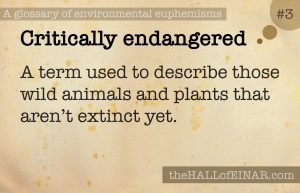Biodiversity – a glossary #2
Biodiversity is a pretentious term used by people who want to sound as if they understand something that you don’t. Usually, using it means that they don’t understand it.

The Earth is 4.5 billion years old. The earliest evidence of life is 3.5 billion years ago. This means there is diversity in the genetic makeup of species, there is diversity in the number and type of species and there is diversity in the complex ecosystems in which they live and interact. The interactions between organisms and each other have formed a natural balance over evolutionary time. In just a few hundred years we have extinguished much genetic diversity, made many species extinct, and seriously impacted on the natural processes in the natural systems in which everything lives.
Can you measure the biodiversity of an ecosystem? It’s as difficult as understanding what someone’s thinking by looking at a brain scan. My local wildlife charity uses the word biodiversity all the time. It’s usually used when they want volunteers for wildlife gardening. It’s often because they want to do some ‘habitat management’. It’s also usually because they want to have another species of butterfly. Wildlife charities are often run by people who are fixated and obsessed with rarities. A classic example is the ‘Devon Special Species’ initiative, where a group of well-meaning but horribly misled rarity fetishists ignore the need for wide restoration of the natural world and instead spend their time on ‘ticks’ of ‘nationally rare’ species. Many of these species are common elsewhere, including just over man-made borders in mainland Europe. Why spend thousands of pounds on wildlife gardening for a few species when we could be seizing land and leaving it alone?
Tropical rainforests cover 10% of the Earth and yet have 90% of the species. Conservation organisations should be campaigning to ban the import of meat and palm oil from tropical areas. Not gardening for butterflies.
If you’d prefer not to know this, here’s a Butterfly:

A Glossary of Environmental Euphemisms
 Organic food – a glossary #4 "Is organic food any better for you?", people ask, as if that's the only worthwhile question to ask. A follow… read more
Organic food – a glossary #4 "Is organic food any better for you?", people ask, as if that's the only worthwhile question to ask. A follow… read more Critically endangered – a glossary #3 Life on Earth is in dire trouble. The Living Planet Report 2020 reports: "The global Living Planet Index continues to… read more
Critically endangered – a glossary #3 Life on Earth is in dire trouble. The Living Planet Report 2020 reports: "The global Living Planet Index continues to… read more Conservation – a glossary #1 Conservation sounds like it should be a good thing, a thing with which everyone agrees. We all want to conserve… read more
Conservation – a glossary #1 Conservation sounds like it should be a good thing, a thing with which everyone agrees. We all want to conserve… read more